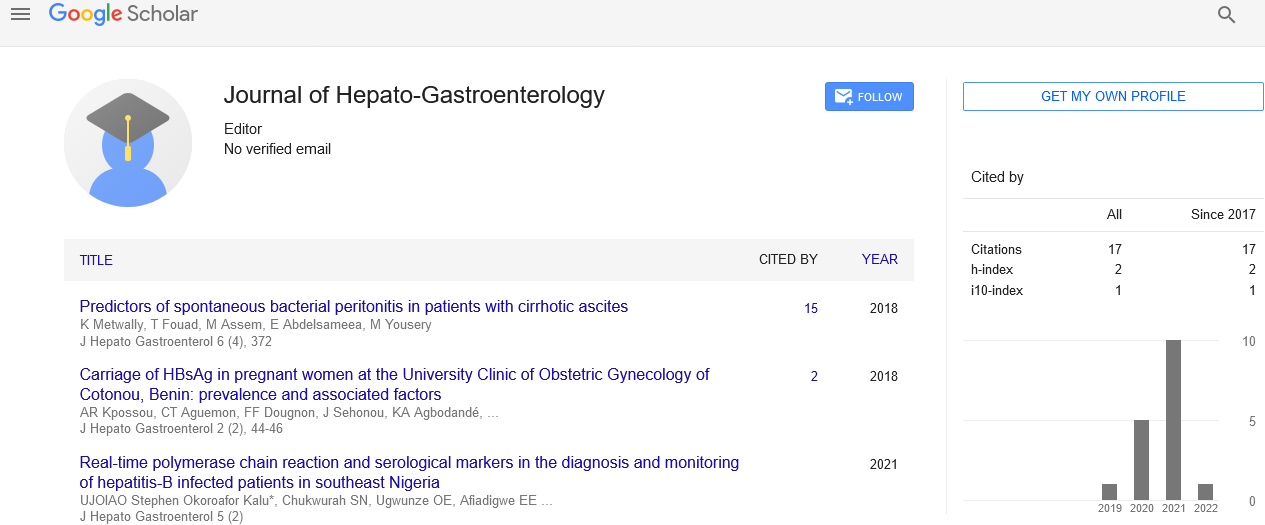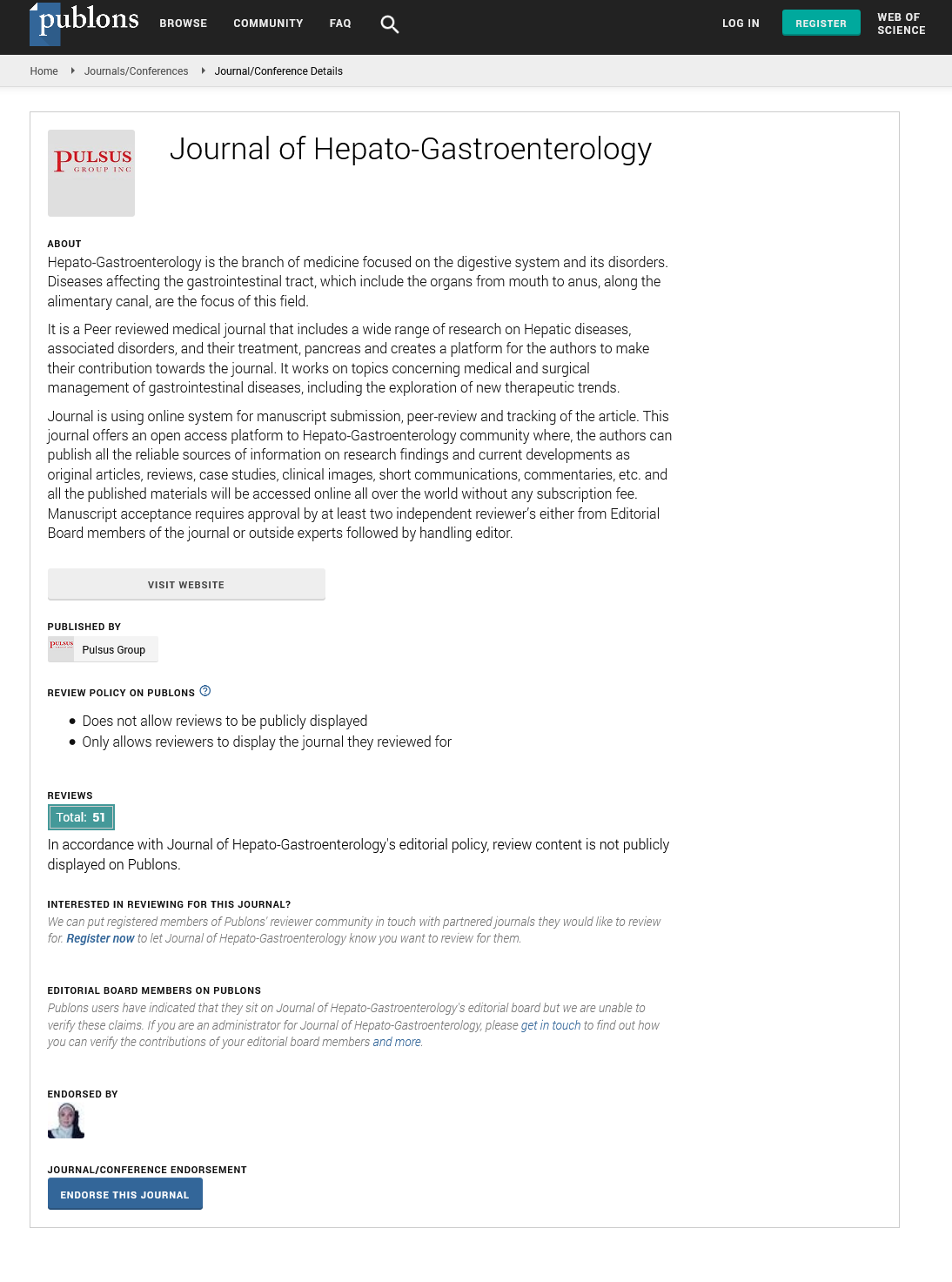Short note on hepatic encephalopathy
Received: 09-Jan-2022, Manuscript No. PULHG-22-4266; Editor assigned: 13-Jan-2022, Pre QC No. PULHG-22-4266 (PQ); Accepted Date: Jan 12, 2022; Reviewed: 19-Jan-2022 QC No. PULHG-22-4266; Revised: 23-Jan-2022, Manuscript No. PULHG-22-4266 (R); Published: 26-Jan-2022, DOI: 10.37532/pulhg.6.1.1-2
Citation: Cooper E. Short note on hepatic encephalopathy. J Hepato Gastroenterol. 2022;6(1):1.
This open-access article is distributed under the terms of the Creative Commons Attribution Non-Commercial License (CC BY-NC) (http://creativecommons.org/licenses/by-nc/4.0/), which permits reuse, distribution and reproduction of the article, provided that the original work is properly cited and the reuse is restricted to noncommercial purposes. For commercial reuse, contact reprints@pulsus.com
Abstract
Hepatic encephalopathy is a sensory system issue welcomed on by extreme liver illness. At the point when the liver doesn’t work asexpected, poisons develop in the blood. These poisons can go to the mind and influence cerebrum work. Individuals with hepatic encephalopathy might appear to be befuddled. Medicines can free the group of poisons and opposite this transitory condition
Key Words
Encephalopathy; Intraluminal; Polyethylene glycol
Introduction
Obvious hepatic encephalopathy is a for the most part reversible neurologic difficulty of cirrhosis. Obvious hepatic encephalopathy has been related to helpless hospitalization-and mortality-related results, which is significant given expanding hepatic encephalopathy-related hospitalizations over the long haul. Hepatic Encephalopathy (HE) is not kidding however possibly a reversible issue with a wide range of neuropsychiatric irregularities and engine unsettling influences that reach from gentle change of mental and engine capacity to unconsciousness and demise. It is a difficult entanglement of cutting-edge liver illness and is assessed to happen in 30% to 45% of patients with liver cirrhosis and in 10% - half of the patients with transjugular intrahepatic portosystemic shunts. HE is frequently a genuine sequela of constant liver infection with critical grimness, mortality, and medical care costs. In the United States, HE represents 22,931 hospitalizations with a normal stay of 8.5 days and a complete expense of $64,108 per case. Lactulose (beta-1, 4-galactoside-fructose) has been the norm of care for the board of Hepatic encephalopathy for quite a long time. Lactulose is a non-absorbable manufactured disaccharide that comprises galactose and fructose connected by a bond impervious to lactase.
Background
Lactulose isn’t consumed by the small digestive system however goes through maturation in the colon to yield short-chain greasy corrosive, carbon dioxide, and hydrogen, with subsequent bringing down of waste PH. The system of activity of lactulose is multifactorial and is proposed to be the catching of ammonium particles in the stomach by natural acids delivered after microscopic organisms use lactulose or the expulsion of ammoniagenic life forms and additionally substitution of these species with acidophilic microbes lacking urease. Others have proposed that restraint of gastrointestinal glutamine take-up and resulting diminished smelling salts beginning assumes a part. Polyethylene Glycol (PEG) is an iso-osmotic diuretic that is metabolically idle and ready to tie water particles, subsequently expanding intraluminal water maintenance. The stake isn’t processed by colonic microorganisms. Ingestion of PEG prompts an increment in stool volume and gentler stools, which might become fluid contingent upon the volume of PEG consumed. The stake is being read up for the treatment of hepatic encephalopathy in patients with cirrhosis and restricted exploration has shown constructive outcomes. There are not very many investigations looking at lactulose and PEG in HE, and Indian information on this correlation is inadequate. So in this concentration, our point was to decide regardless of whether PEG might address an extra restorative choice for the treatment of patients with unmistakable Hepatic encephalopathy. When contrasted and lactulose, the current standard treatment for plain HE, objective proportions of HE in the initial 24 hours, further developed fundamentally quicker in those getting PEG. By speeding up progress in mentation, starting treatment with Stake can abbreviate hospitalizations, however likewise grant medical services experts to focus on dealing with the accelerating factors and distinguishing different causes of metabolic encephalopathy that might be available. Since our review was little, single focus-based, there might be a need for multicentric, huge preliminaries to additionally affirm its adequacy. Bigger and multicenter preliminaries with various portions of PEG, ought to be performed to make PEG a standard treatment for patients with cirrhosis and HE. Concentrating on contrasting, a mix of (PEG+Lactulose) versus lactulose alone should be embraced to decide if Stake can be a powerful extra treatment choice for HE.
Symptoms
• Anxiety or irritability
• Cognitive impairment (confused thinking or judgment)
• Coordination or balance problems
• Difficulty concentrating or short attention span
• Flapping hand motion (asterixis)
• Mood or personality changes
• Muscle twitches (myoclonus
Causes
• Liquor use
• Certain medications influence the sensory system, like dozing pills and antidepressants
• Stoppage (being not able to pass stool, or crap, ordinarily)
• Lack of hydration or electrolyte lopsidedness
• Gastrointestinal system dying
• Disease
• Kidney illness
• Liver shunt
Treatment
Treatment changes rely upon your side effects and generally speaking wellbeing and how serious the condition is. It’s critical to take meds for hepatic encephalopathy precisely as endorsed. With treatment, it’s feasible to slow, and some of the time stops, the illness from deteriorating. Your PCP might suggest either of these medicines:
Anti-infection agents: Bacteria in your body make regular poisons from processed food sources. Antimicrobials, for example, rifaximin (Xifaxan®), stop bacterial development. Therefore, the body produces fewer poisons.
Intestinal medicines: Lactulose oral arrangement, a purgative produced using lactose sugar, brings poisons into the colon. The diuretic animates successive solid discharges that assist with eliminating poisons from the body.






